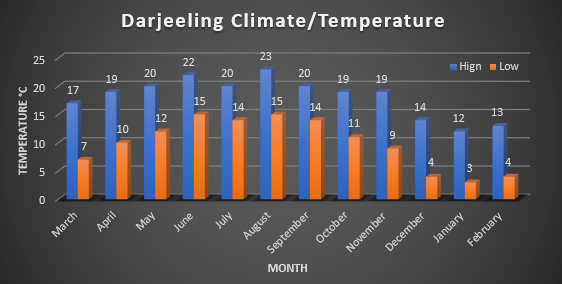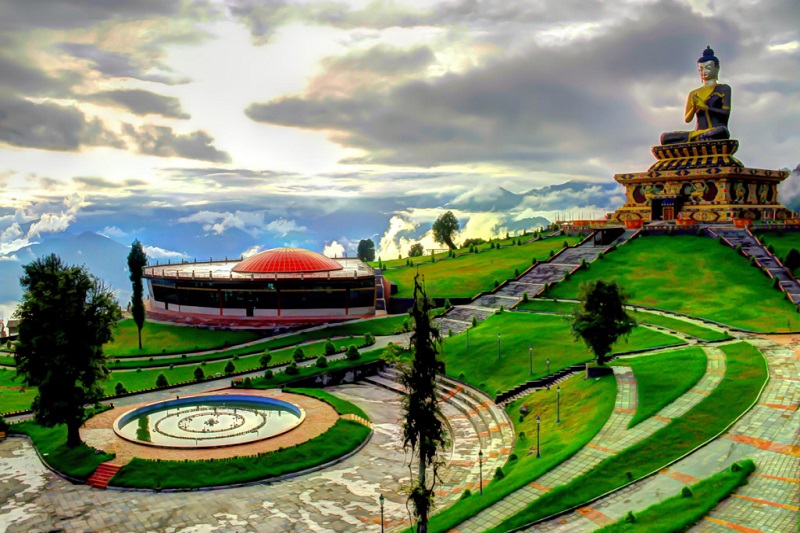North Sikkim - 5 Day / 4 Night
- Day 1
- Day 2
- Day 3
- Day 4
- Day 5
Bagdogra/NJP to Gangtok
Overnight stay at Gangtok.
Gangtok to Lachen
Overnight stay at Lachen.
Lachen to Lachung with sight-seeing.
Gurudongmar lake
Overnight stay at Lachung.
Lachung to Gangtok with sight-seeing
Yumthang valley
Overnight stay at Gangtok.
Gangtok to Bagdogra/NJP drop.
About Darjeeling
Sikkim is located in North-East part of India at an elevation of 837.93 meters (2749.11 feet) above sea level, Sikkim has a Tundra climate (Classification: ET). The city’s yearly temperature is 14.48ºC (58.06ºF) and it is -11.49% lower than India’s averages. Sikkim typically receives about 105.45 millimeters (4.15 inches) of precipitation and has 168.44 rainy days (46.15% of the time) annually. One of the unique places in India for tourism.
The best months to visit Darjeeling are April through June because of the lovely weather. Many individuals, however, also favour going there in the winter, from October through December. The showers are welcomed in the months of July and August. Since the hill resort experiences a lot of obstacles after heavy rain, it is not recommended to travel to Darjeeling during these months.
From October through March, the weather drastically changes; by the end of October, there is a light chill in the air. The coldest part of winter, which lasts from the middle of November to the beginning of January, with temperatures between 7 and 5 degrees Celsius. The start of the city’s summer season is from April to June. Darjeeling is nice and not overly hot throughout these months. The maximum temperature is 25 degrees. It’s perfect for exploring the tourist attractions because of the strong sunlight that pours in. Again, September is a great month to travel because there is less rain and more lush vegetation at this time of year.
Best time to Visit Darjeeling
- Winter (November - February)
- Spring (March-May)
- Summer (June - July)
- Monsoon (June - September)
- Autumn (September - October)
The peak tourist period in Darjeeling is from March to May, when you may expect the greatest influx of visitors. It's not difficult to understand why. The weather, which is between 15 and 20 degrees, is wonderful to be in. While not being too harsh on your skin, the mild sun warms you just enough to participate in outdoor activities and sightseeing. The breeze that blows through the pines is pleasant to the ears, and the winds are also favourable. As the winter months pass, spring brings with it new magnolia and rhododendron blossoms, bringing nature to life in this charming hill town.
The peak travel period in Darjeeling is from March to May, when you may expect the greatest influx of visitors. It's not difficult to understand why. The weather, which is between 15 and 20 degrees, is delightful to be in. While not being too harsh on your skin, the mild sun warms you just enough to participate in outdoor activities and sightseeing. The breeze that blows through the pines is pleasant to the ears, and the winds are also favourable. As the winter months pass, spring brings with it new magnolia and rhododendron blossoms, bringing nature to life in this charming hill town.
Take the renowned Darjeeling Himalayan Railway to start your trip to Darjeeling and experience the hills like never before! Though June and July get more rain than the spring months, the summer brings a large number of tourists to Darjeeling. Do not let this discourage you because showers won't start until August. Bringing suitable clothing and rain protection is advised. Darjeeling is pleasant in the summer with temperatures ranging from 18°C to 25°C, attracting visitors from all over India and the world. Visit the Japanese Peace Pagoda to reflect on life, or visit Darjeeling Chowrasta to walk among the residents and take in the culture. The Ghoom Monastery offers peace and calm, making it the ideal setting for self-exploration and reflection. You can see the snow-covered Kanchenjunga mountain magnificently because the sky is comparatively clear. When July approaches, the number of visitors declines and prices start to fall. For budget-conscious travellers, this is perfect.
The monsoon season is the least desirable time of the year to travel to Darjeeling because of the 93–96% humidity and 700 mm of rain that fall during those four months. Landslides are a possibility as well, however they only occur in specific passes. The weather is pleasant with 15°C to 20°C temperature ranges. Some tourist activities are halted by heavy rains? Although the cable car and toy train rides are currently suspended, the town still looks lovely after a rainstorm. Darjeeling in the monsoon is particularly tempting if you want beautiful and mesmerizing landscapes. In the rain, the verdant, luxuriant plantations appear ethereal, and the town exudes a vintage romance. The town looks like it sprang straight out of a picture thanks to the foggy streets and misty highways, which is perfect for a budding photographer. In this lovely village, put your photography talents to the test!
The second tourist season in Darjeeling starts in the fall, however it is less crowded than the summer. The monsoon renews the area as a whole, preparing it for the autumn breeze. The temperature decreases to 10–17°C, and there are only a few isolated showers and low humidity. Adventure lovers and adrenaline addicts should visit Darjeeling right now because there are so many things to keep you occupied. Trek to Sandakphu to see the sunrise, or ride a mountain bike across the varied terrain's curves. You can raft down the Teesta River and conquer it, or you can enrol in a rock-climbing course at the Darjeeling Mountaineering Institute. Jog while the majestic Kanchenjunga watches you as you move across the lovely valley. Although it is best to make reservations in advance to avoid last-minute rushes, prices are not as pricey as during the summer.
Things to Do
At Tinchuley Valley, tuck into spicy momos and crunchy churpi, two must-try local treats, and learn about the way of life there. Ride the Passenger Ropeway over rivers and waterfalls while admiring the peaks covered in snow as they pass. Winter hikes to local monasteries and vistas are an option. The lofty mountains are given an ethereal appeal by the glaciers. Best time to go in Winter. The coldest month of the year is January, which occasionally has snowfall. Pack appropriate winter clothing because the majority of low-cost hotels do not provide enough heating choices in the rooms. Wintertime costs are low and hotels are less expensive. The precise translation of “Darjeeling” is “Land of the Thunderbolt,” and it offers a wide range of travel alternatives. Do not overlook this gem!
The greatest month for touring is March because it has one of the lowest annual humidity levels. You are fascinated by the many tea estates that are scattered over the hills. Some plantations also allow tea plucking! With your family, observe the complete tea-making process, from leaf to brew, and have a cup of the renowned Darjeeling tea. At Tiger Hill Point, witness the magnificent sunrise as the sun rises over Kanchenjunga Peak. the highest mountain in India. Barbotey Rock Garden strolls, astronomy at Darjeeling Observatory, wool and trinket shopping at Bhutia Market, and praying at the diverse Mahakal Temple are all recommended. Stunning views of the Himalayas are possible thanks to the generally clear sky. Families should visit Darjeeling at this time of year because of these enjoyable activities. But be prepared for sporadic hail storms by bringing an umbrella. It is best to reserve your travel and lodging in advance if you intend to visit Darjeeling in the spring or summer because prices increase as the tourist season draws near and most hotels are fully booked by June.







